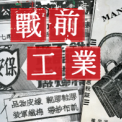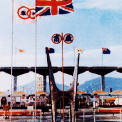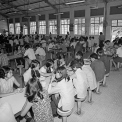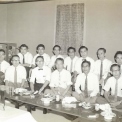-
History & Society
- Education in Pre-war Hong Kong
- History of Taikoo Sugar Refinery
- Hong Kong Products Exhibition
- Local Festivals Around the Year
- Post-war Industries
- Pre-war Industry
- The Hong Kong Jockey Club Archives
- Tin Hau Festival
- Memories We Share: Hong Kong in the 1960s and 1970s
- History in Miniature: The 150th Anniversary of Stamp Issuance in Hong Kong
- A Partnership with the People: KAAA and Post-war Agricultural Hong Kong
- The Oral Legacies (I) - Intangible Cultural Heritage of Hong Kong
- Hong Kong Currency
- Hong Kong, Benevolent City: Tung Wah and the Growth of Chinese Communities
- The Oral Legacies Series II: the Representative List of the Intangible Cultural Heritage of Hong Kong
- Braving the Storm: Hong Kong under Japanese Occupation
- A Century of Fashion: Hong Kong Cheongsam Story
Geography & EnvironmentArt & Culture- Calendar Posters of Kwan Wai-nung
- Festival of Hong Kong
- Ho Sau: Poetic Photography of Daily Life
- Hong Kong Cemetery
- Sketches by Kong Kai-ming
- The Culture of Bamboo Scaffolding
- The Legend of Silk and Wood: A Hong Kong Qin Story
- Journeys of Leung Ping Kwan
- From Soya Bean Milk To Pu'er Tea
- Applauding Hong Kong Pop Legend: Roman Tam
- 他 FASHION 傳奇 EDDIE LAU 她 IMAGE 百變 劉培基
- A Eulogy of Hong Kong Landscape in Painting: The Art of Huang Bore
- Imprint of the Heart: Artistic Journey of Huang Xinbo
- Porcelain and Painting
- A Voice for the Ages, a Master of his Art – A Tribute to Lam Kar Sing
- Memories of Renowned Lyricist: Richard Lam Chun Keung's Manuscripts
- Seal Carving in Lingnan
- Literary Giant - Jin Yong and Louis Cha
-
History & SocietyGeography & EnvironmentArt & Culture
-
View Oral History RecordsFeatured StoriesAbout Hong Kong Voices
-
Hong Kong MemoryPost-war IndustriesRecently Visited
Industry Focus
The implications of Hong Kong watch industry
Clocks are devices for measuring time, and were invented in fourteenth century Europe. As their size gradually reduced, clocks turned into pocket watches (sometimes attached to a chain), wristwatches and others. Beginning from the early twentieth century the wristwatch became the most popular of timepieces. The Europe and the U.S. have hundreds of years of history in the watchmaking industry. Switzerland, being the kingdom of timepieces since the nineteenth century, has produced mechanical watches under famous brands and exported them to the global market.
The watch industry includes producing the watch movement, the components and the assembling. The watch movement is the heart of a timepiece and is precisely assembled by many components like gears and springs with the most advanced technical requirements. It is an international rule to define the origin of a watch by the origin of the watch movement. Accessories of watches refer to the watch strap, watch case, watch face and watch crown etc. Watch assembly requires the assembly of the watch movement and the accessories.
After the war, the watch industry in developed countries shifted their focus to Asia. Watch factories from Europe and the U.S. sourced and produced watch components from the Far East. Hong Kong caught the trend and after three decades of development it turned from an import and export harbour for the components and watches to a region which manufactured watches. As the production of watch movement required substantial investment in funding and technology, production and development of local watch movement was limited to a few foreign factories composing the movements. A large part of the Hong Kong watch industry was dedicated to the production of the components and assembling of watches.
In the past, wristwatch was a luxury item and the general public could not afford it. Watch repair usually went to the retail. Starting from import and expert, wholesale, retail and repair, Hong Kong watch industry began manufacturing since the end of the 1930s. Home-style workshop for making watch straps and watch cases appeared and their products were used by watch repair shops. Factories manufacturing components in streamlined production appeared after the war.
The evolution of Hong Kong watch industry: from production of components to watch assembly
The investment for the technology and equipment for watch components is relatively low and this industry is labor-intensive. Years after the war, a large number of immigrants from the Mainland came to Hong Kong, bringing an abundance of cheap labor. Watch masters took the opportunity to set up small workshops for producing straps and watch cases. Among all watch components, the manufacturing quantity of straps and watch cases was the highest and the processes involved were also the most cost-effective. Such were the beginnings of watch manufacturing industry in the Hong Kong.
Watch strap is the first product of Hong Kong watch industry and it can be categorized as leather straps and metal straps. Straps had the highest export value in the 1970s. Early strap factories were operated informally in the form of home-style workshops; they were family businesses which employed a large number of female workers. The strap industry was the first to attract foreign investments. In the late 1950s, Canadian Tools Ltd. set up factories in Cheung Sha Wan and started to produce patent straps called "steel gate straps".
Local watch case production began in the 1930s. Many founders of the watch case factories were originally masters of mechanics or metal ware. In the 1950s to the 1960s, most of the watch case factories were located in Chinese-style old tenements or ground floor in old districts which were run in family-style. They were poorly equipped. They used domestic machines to grind the case which relied on the skills of the masters to control the quality. Most of the workers operating the machines obtained their skills through apprenticeship.
From post-war to the 1970s, there was a clear division of labour in the watch components manufacturing industry. Factories of watch case and strap manufactured only one kind of products for export. The products of the component factories evolved with the watch trend. In the late 1970s, electronic and quartz watches were launched respectively and local component factories were too busy to take orders which resulted in out-sourcing and sub-contracting modes of production. In the 1980s, the component factories gradually took the mode of multi-processes and their businesses expanded to the manufacturing of other components or watch assembling.
The year 1969 was the watershed in history of Hong Kong watch industry as the total export value of watches exceeded the export value of watch components for the first time. Watch assembling required only simple techniques and the investment cost was not high so Hong Kong already had favorable conditions for its development. The key reason why watch assembly saw better development as a latecomer was the supply of the watch movement. In 1953, a large number of watch movements were imported to Hong Kong from Germany. Later, Switzerland also lifted the export ban. In 1966, the Soviet Union also started supplying Hong Kong with machines for watch manufacturing. Early products supplied to Hong Kong were mainly mechanical movements which could be assembled into fair-priced mechanical watches. They were commonly known as "pin levers" in the industry.
The Watch assembling industry and watch component industry in Hong Kong share a symbiotic relationship. In the mid-1950s, the local watch component industry had a good foundation and they provided adequate supply for straps and watch cases. The fair-priced watch movements imported from Europe allowed the watch assembling industry to flourish; and the local watch assembly industry in turn helped boost the production of the components. In the late 1960s, a large number of Swiss movements were supplied to Hong Kong and thus watch assembling replaced watch component production and became the mainstay of the Hong Kong watch industry. From 1968 to 1974, the export quantity of Hong Kong watches had grown five-fold while the export value grown eight-fold. From the end of 1970s to the mid-1980s, electronic and quartz watches were launched and the movements were far cheaper. Local factories imported a large number of electronic and quartz movements. Some local electronics factories also supplied electronic movements. The capacity and yield of watch assembling were greatly developed. In 1992, Hong Kong watches accounted for seventy percent of the world’s supply and the industry became one of the four major export contributors in Hong Kong.
The evolution of watch assembling: from mechanical to electronic and to quartz watches
According to the parts and kinetics of the movement, watches can be divided into three categories: mechanical, electronic digital and quartz watch with hands. Before the 1970s, mechanical watch was most popular and it could be divided into pin-lever and jewel-lever watches. In the former, the movement has only one gem while the latter, the more expensive ones, could have seventeen gems. Before the 1950s, Hong Kong watch factories imported pin-lever movements and used local components to assemble middle to low price pin-lever watches. They were exported to the markets in the U.S., Japan and the Middle East.
In the early 1970s, electronic digital watch brought a significant revolution to the watch assembling industry. Light Emitting Display (LED) and Liquid Crystal Display Watch had successfully developed in the U.S. Right after the Americans landed on the moon, people began to apply space science and technology to industrial production. When initially launched, electronic watches were sold rather expensively and quickly became a fashionable luxury item in the watch market. Electronic movement technology became popular in the 1970s and digital watches were mass produced in the factories in the U.S. and Japan which caused a significant drop in the cost and price of electronic watches.
Between 1974 and 1975, Hong Kong watch factories began assembling electronic watches. In 1979, electronic watches replaced digital watches and had the highest export value in the watch category which established Hong Kong’s significant status in the global watch market. From 1975 to 1980, the number of local registered watch factories increased from 237 to 1187 and a large number of manufacturers joined and produced electronic watches. Local electronic factories also supplied electronic movements. The excessive production of electronic watches triggered competitive price cuts which, coupled with export restrictions from the traditional watch manufacturing countries, led to a decline in the electronic watch industry in the mid-1980s. Many factories closed because the business was unprofitable.
After the boom of electronic watches, analogue quartz watches became the mainstream. Quartz watch was successfully developed as early as the late 1960s. The principle is based on timing with the vibration of quartz. Battery-powered, deviation in accuracy is no more than two seconds per year. There are fewer components in the movement of a quartz watch and the production processes are simple. In the early 1980s, Europe and the U.S. factories switched to produce quartz movements. In 1984, quartz watches became the major watches made in Hong Kong. In 1983, the Swiss Swatch Group launched the plastic watch "Swatch" and brought about a consumer boom around the world. Watches transformed from a timing device to a fashion item. There were huge demands in the market. The Hong Kong watch industry has entered its golden era.
The change in the supply chain in watch related products
Hong Kong’s watch component factories supply their goods to local and overseas markets. Local customers are watch component and assembling factories while overseas customers include importers and overseas watch factories. In the early years, watch component factories had limited financial resources and knowledge so they were not able to export watches directly. They usually obtained overseas orders through exporters. Sometimes the importers will send buyers to Hong Kong on a regular basis, for example, W. M. R. Watch Case Corporation and Pilamontrex Inc. from the U.S. Both were not watch companies but they were the main customers ordered from the Hong Kong watch case factories in the 1950s and 1960s. By the 1970s, many watch component factories gradually grew to a certain scale and they grasped the information to expand the market. They sent staff to directly contact customers in Europe and in the U.S., seeking stable order sources. It also allowed them to obtain more profit without the exporters as the middleman so their business could develop to a higher level.
Watch assembling factories also supplied their goods to local and overseas markets. In the 1960s, local watch assembling industry promoted the development of local watch retail industry. Large-scale watch factories also purchased exclusive rights in selling foreign brand watches and they hired salesmen called the “street promoters” and promoted to the watch retailers. They also promoted to the consumers through advertisement and the Hong Kong Brands and Products Expo. Watches were on the shopping lists for tourists in Hong Kong in the 1950s and 1960s and brought vitality to the whole watch industry.
Hong Kong's entrepot trade for watches had a longer history. Hong Kong acted as an entrepot in the 1960s and mainly imported Swiss watches and exported them to the South Pacific and Commonwealth countries. In the mid-1960s, local watch assembling industry bloomed and the U.S. became the largest market; in the early 1980s, the watch manufacturing industry of Hong Kong reached its climax with clients from all around the world. After the 1980s, communication and transport conditions became mature, coupled with the popularity of the International Watch Fair, local watch factories became more capable of directly exporting their products. The business of exporters as the middleman declined. Many watch component factories and watch factories further developed their cooperation with overseas watch companies. In the 1980s and the 1990s, Hong Kong watch factories manufactured and sold brand-name watches to overseas by Original Equipment Manufacturing (OEM) and franchise licensing.
Relocation to the north and industry transformation
After 1985, it became a common practice in the watch industry to relocate northward. The end of the 1980s was the peak of the relocation. In the early stages, Hong Kong businessmen mainly started up factories by processing imported raw materials, and the factories in China were responsible for production or assembly. The finished products were transported back to Hong Kong for packing and exported overseas.
The production capacity was raised by relocating the production line to the north and huge OEM orders could be taken which increased sales and profit. Many watch factories reached their peak in business after relocating to the north. In the early 1990s, watch factories in Hong Kong closed down their local production line and the remaining offices were used only for such functions as accounting, shipping, and order processing. With the healthy development of mainland factories, relevant departments have been gradually relocated to the north.
In the 1990s, with rapid development of the economy in China, the purchasing power of urban residents grew. Watches made in Hong Kong became a symbol of a wealth and identity. With the opening up of the mainland market, some Hong Kong businessmen strived to promote sales in China and transformed the mainland factories into sino-foreign cooperative joint ventures and set up retail outlets in the cities in China. Brand was the key in retail business so many Hong Kong watch factories established their own brand or obtained the patent from overseas brands so as to enhance the publicity of their enterprise and their products.
The 1990s was the transformation period for local watch enterprises. Many watch companies had built a good foundation and developed in the 1920s and 1930s. In addition, their businesses were taken over by their second generation successors who were educated in the west had sound financial knowhow and knowledge. Large-scale watch factories set plans to raise capital through listing in the market and to diversity their businesses.
Watch Manufacturers Association
The Federation of Hong Kong Watch Trades and Industries Ltd. and the Hong Kong Watch Manufacturers Association are two major watch manufacturers’ associations. The Federation of Hong Kong Watch Trades and Industries Ltd. was established in 1945, formerly "Watch Art Society" and "Hong Kong and Kowloon Watch Association". Its members were mainly engaged in trade, wholesale, retail and repair, and gradually manufacturers engaged in the watch components business joined as members. Since 1949, the Federation has been publishing the Clock and Watch magazine. Hong Kong Watch Manufacturers Association was established in 1968, formerly known as "Hong Kong Roskopf Assemblers Association Ltd.". Members were mainly from the component factories and watch assembling factories; "Roskopf" means "pin-lever". In the early years the association spared no effort in promoting the manufacturing and trading of jewel-lever watches. The association had published a member magazine called Hong Kong Watches.
References
1.) Interview with Chong Hok Hoi, 27 September 2010.
2.) Interview with Leung Wai Ho, 21 August, 28 August and 18 September, 2010.
3.) 何紹華,「展望一九五九年香港鐘表業」,《鐘與表》(第10期,1959年),香港: 香港鐘表業總會,頁57。
4.) 馮冠齋,「邁進中的香港鐘表工業」,《鐘與表》(第10期,1959年),香港: 香港鐘表業總會,頁35-36。
5.) 紹,「從發展旅遊事業談到鐘錶門市」,《鐘與表》(第10期,1959年),香港: 香港鐘表業總會,頁69。
6.) 謝天申,「十六年來香港鐘錶業海內外市場的檢討」,《鐘與表》(第11期,1960年),香港: 香港鐘表業總會,頁63及65。
7.) 華,「日本鐘表進軍香港」,《鐘與表》(第13期,1962年),香港: 香港鐘表業總會,頁63。
8.) 兆華,「香港的鐘表附件工業」,《鐘與表》(第13期,1962年),香港: 香港鐘表業總會,頁73。
9.) 「石英手表(弍)」,《鐘與表》(第20期,1969-70年),香港: 香港鐘表業總會,頁43、45、47。
10.) 梁派泉,「香港的表壳業」,《鐘與表》(第28-29期,1977-79年),香港: 香港鐘表業總會,頁35。
11.) 梁派泉,「香港表殼業發展簡略」,《香港時表》(第二期,197X年),香港: 香港表廠商會,頁53。
12.) 嚴慶森,「表業概況」,《香港時表》(第二期,197X年),香港: 香港表廠商會,頁18-19。
13.) ‘Making Time’, Hong Kong trade bulletin, Hong Kong: Dept. of Commerce and Industry (March 1957), p.148.
14.) ‘Watch-cases’, Hong Kong trade bulletin, Hong Kong: Dept. of Commerce and Industry (March 1959), p.70-71.
15.) ‘Time-pieces’, Hong Kong trade bulletin, Hong Kong: Dept. of Commerce and Industry (June 1960), p.183-184.
16.) ‘Watch-bands, Hong Kong trade bulletin, Hong Kong: Dept. of Commerce and Industry (July 1962), p.298-299. 17.) 王冠之、王錫年著,《香港鐘表工業發展史》,香港 : 香港錶廠商會有限公司, 1993年。
Copyright © 2012 Hong Kong Memory. All rights reserved.









